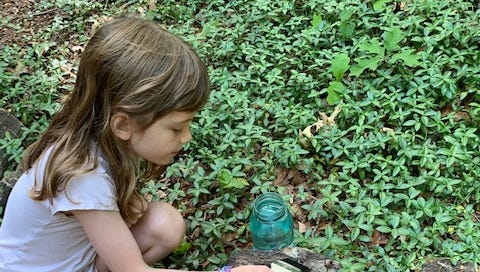Everyone is talking about the Brood X cicadas—the red-eyed bugs are emerging now to sing a cacophonous, monthlong mating song in in parts of Indiana, Maryland, Ohio, New Jersey, Pennsylvania and Tennessee. Periodical cicadas live seventeen (or thirteen, depending on the brood) years underground as nymphs, then emerge to shed their skins, sprout wings, fly to the treetops, sing, mate, lay eggs, and die (their above-ground lives are about four to six weeks long).
No one knows exactly how they know when to emerge, but scientists think that cicadas may have an internal clock that allows them to sense how many years have passed through changes in the tree sap they eat underground as nymphs (!). Given the crazy interconnectedness of nature, it’s no wonder that scientists fear that climate change and deforestation, both manmade problems, could threaten the survival of cicadas.
Some people hate the noise, but we think it’s cool and interesting. Check out this time-lapse video of a cicada emerging from its larval shell:
And here’s a fun, informative (and also moving!) video interview with entomologist Samuel Ramsey, who explains why cicadas are so loud (the loudest insects on the planet!), and why we should appreciate them:
In our part of North Carolina, the next big cicada year is 2024—the Triangle and Triad won’t experience the intensity of Brood X, but we’ll still be able to hear our annual cicadas. We can still see and study other cool insects in the meantime, including fireflies, moths, and butterflies.
Bea and Harriet and I love finding moths and butterflies on our walks. Last summer, Bea and I mysteriously found eight different sets of Luna moth wings on the path to the river (all on a single walk), plus a few more in the woods behind our house. Luna moths are endangered, large, lime-green moths with beautiful markings. We read that they live such a short time as moths—about a week—that they don’t even have mouths!
Harriet’s cousins gave her a great book called Fun with Nature Take-Along Guide that has a lot of information and activities about common animals and plants. We were reading about moths and learned a few helpful tips for telling the difference:
-Most, but not all, moths fly at night. Butterflies fly in the daytime.
-Butterflies land with their wings pointing up. Moths land with their wings flat.
-Butterflies have slender bodies, and moths have thicker bodies.
-Butterflies have thin, smooth antennae with small knobs at the end. Moths have thick, feathery antennae.
Both moths and butterflies use their antennae to feel and smell. Moths can actually smell their food from miles away, and you can attract them using this simple “moth sugar” experiment.
How to make moth sugar
By Bea (adapted from the Fun with Nature Take-Along Guide)
You need a quart jar (a quart is four cups). Fill it up with water, then add three tablespoons of sugar. Stir until all the sugar dissolves.
Then get some old paintbrushes and paint the moth sugar onto rocks, pavement, or a sidewalk in your yard.
Do this in the late afternoon, on a warm day, so that the sugar-water gets baked into the rocks by the sun (but doesn’t totally evaporate).
After it gets dark, check your rocks. You should see some moths! You can check this field guide to see who visited you.
Do you have a favorite insect sound that says “summer”? Harriet loves crickets. I love cicadas. Bea loves the whole bug symphony.





I enjoyed reading this post and watching the two videos so much! Today's post is absolutely saturated with fascinating information. I can't wait to try the moth sugar experiment with my little budding entomologist! Thank you so much! We love you.
Dear Bea, Harriet and Belle
I want to tell all three of you how much I enjoy receiving and reading the Frog Trouble Times. Your adventures sound so interesting and fun and like such good projects for the Tough Girls Club to undertake! On behalf of people like me who spend a lot of time indoors with their work, I especially want to thank you for paying such careful attention to the outdoors and for sharing what you learn and do with the rest of us. Outdoors is such a fun place to play and learn because something is new there to see or find every day. Since the outdoors and nature are having big challenges, I am very happy to know that the three of you are looking out for them, helping keep nature beautiful and helping make her even stronger than she is right now, getting her back to the place she was before so many of us humans came and started being hard on her.
Many thanks! Keep up the good work and keep writing. Becky Campbell